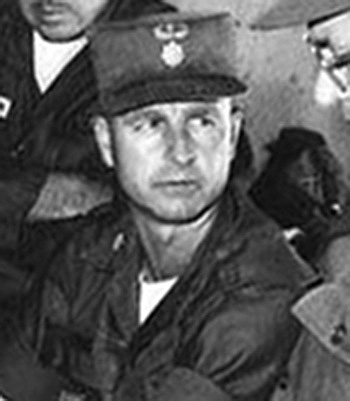John Vann was born on July 2, 1924, in Norfolk, Virginia. He enlisted in the Aviation Cadet Program of the U.S. Army Air Forces on March 10, 1943, and after leaving the Pilot training course, he transitioned into the Navigator course and earned his commission as a 2d Lt and his Navigator Wings in 1945. Lt Vann remained in the Army after the Air Force became a separate service in 1947, and transferred to the Infantry, later serving with the 25th Infantry Division and leading a Ranger company during the Korean War. After the Korean War, Capt Vann served with the 16th Infantry Regiment in West Germany from 1954 to 1955, and then served with Headquarters U.S. Army Europe in West Germany from 1955 to 1957. After attending Command and General Staff College, Col Vann served with the Comptroller Section of the U.S. Army Air Defense Center at Fort Bliss, Texas, from December 1959 to December 1961. His final assignment was as an advisor with the Military Assistance Group in South Vietnam from January 1962 to March 1963. LtCol Vann retired from the Army on August 1, 1963, and then worked for Martin Marrietta from 1963 to 1965, when he joined the Agency for International Development, returning to South Vietnam as a province senior advisor, Deputy for the Civil Operations and Revolutionary Development Support Division of III Corps, Deputy for Civil Operations and Rural Development Support of III and IV Corps, and as senior American advisor for the II Corps Military Region from March 1965 until he was killed in action after the Battle of Kontum, when his helicopter was shot down on June 9, 1972. John Vann was buried at Arlington National Cemetery, and was posthumously awarded the Distinguished Service Cross and the Presidential Medal of Freedom. During the Battle of Kontum, Vann became the first American civilian to command U.S. regular troops in combat, and he was the last civilian to be awarded the Distinguished Service Cross.
His Distinguished Service Cross Citation reads:
The President of the United States of America, authorized by Act of Congress, July 9, 1918 (amended by act of July 25, 1963), takes pride in presenting the Distinguished Service Cross (Posthumously) to John Paul Vann, a United States Civilian, for extraordinary heroism and distinguished service as a U.S. civilian working with the Agency for International Development, United States State Department, in the Republic of Vietnam. Mr. Vann distinguished himself by extraordinary heroism in action during the period 23 April to 24 April 1972. During an intense enemy attack by mortar, artillery and guided missiles on the 22d Army of the Republic of Vietnam Division forward command post at Tan Canh, Mr. Vann chose to have his light helicopter land in order to assist the Command Group. After landing, he ordered his helicopter to begin evacuating civilian employees and the more than fifty wounded soldiers while he remained on the ground to assist in evacuating the wounded and provide direction to the demoralized troops. With total disregard for his own safety, Mr. Vann continuously exposed himself to enemy artillery and mortar fire. By personally assisting the wounded and giving them encouragement, he assured a calm and orderly evacuation. As the enemy fire increased in accuracy and tempo, he set the example by continuing to assist in carrying the wounded to the exposed helipad. His skillful command and control of the medical evacuation ships during the extremely intense enemy artillery fire enabled the maximum number of soldiers and civilians to be safely evacuated. On the following day the enemy launched a combined infantry tank team attack at the 22d Division Headquarters compound. Shortly thereafter, the Army of the Republic of Vietnam defense collapsed, enemy tanks penetrated the compound, and the enemy forces organized .51 caliber anti-aircraft positions in and around the compound area. To evade the enemy the United States advisors moved under heavy automatic weapons fire to an area approximately 500 meters away from the compound. Completely disregarding the intense small arms and .51 caliber anti-aircraft fire and the enemy tanks, Mr. Vann directed his helicopter toward the general location of the United States personnel, who were forced to remain in a concealed position. In searching for the advisors' location, his helicopter had to maintain an altitude and speed which made it extremely vulnerable to all forms of enemy fire. Undaunted, he continued his search until he located the advisors' position. Making an approach under minimal conditions he landed and quickly pulled three United States advisors into the aircraft. As the aircraft began to ascend, five Army of the Republic of Vietnam soldiers were clinging to the skids. Although the total weight far exceeded the maximum allowable for the light helicopter, Mr. Vann chose to save the Army of the Republic of Vietnam personnel holding on to the skids by having the helicopter maneuver without sharp evasive action. Consequently, the aircraft sustained numerous hits. In order to return to Tan Canh as soon as possible to save the remaining advisors and to save the soldiers clinging to the skids, Mr. Vann detoured his aircraft from Kontum to a nearby airfield. Throughout this time Mr. Vann was directing air strikes on enemy tanks and anti-aircraft positions. While en route back to Tam Canh, Mr. Vann's helicopter was struck by heavy anti-aircraft fire, which forced it to land. Throughout the day Mr. Vann assisted in extracting other advisors and soldiers in the Dak To area. On one such occasion another group of army of the Republic of Vietnam soldiers attempted to cling to one side of his helicopter, caused it to crash. Undaunted by these occurrences, Mr. Vann continued directing air strikes and maneuvering friendly troops to safe areas. Because of his fearless and tireless efforts, Mr. Vann was directly responsible for saving hundreds of personnel from the enemy onslaught. His conspicuous gallantry and extraordinary heroic actions reflect great credit upon him and the United States of America.
|



